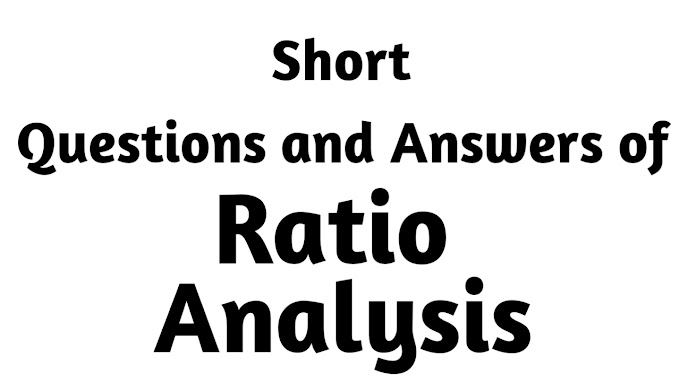Liquidity Ratios
Liquidity ratios measure the ability of the firm to meet its short-term obligations. Short-term is conventionally viewed as a period up to one year. By liquidity, we mean the amount of cash or cash equivalents the firm has not hand and the amount of cash it can arrange in a short period of time. Cash is the most liquid asset. It includes currency, demand deposits with bank. Cash equivalents are short-term highly liquid investments that are readily convertible into known amount of cash and which are subject to an insignificant risk of changes in value. Stock and debtors are somewhat less liquid.
Liquidity is essential for smoothly conducting of business activities.
If the firm of the poor liquidity position, it may not be able to make timely
payments to the the creditors and, in effect, will not be in a position to buy
goods or services in future or credit. Poor or insufficient liquidity may
result in a serious fundamental problem, practically in times of adversity,
such as when a business unit is shut down by strike or a steep rise in the
price of a raw material.
High liquidity provides flexibility to take advantage of changing market
conditions. For example, an ‘Flour’ or ‘Semolina’ manufacturing company can buy
wheat at very cheap rate at harvesting time of its liquidity position is good.
There are number of reasons, apart from the above, why enterprise need
liquidity. They are as under:
(a) To invest in project that were agreed in previously year(s).
(b) To take advantages of an investment opportunity that arises.
(c) To cope up with boom and slump conditions which affect a business in
terms of sales, interest rates, etc.
(d) To keep extra funds were sales are varying, e.g., in a reasons
business.
(e) To meet working capital needs.
The above scenarios highlight why measures of liquidity are to great
importance.
The ratios which indicate the liquidity of an enterprise are:
1. Current Ratio
2. Liquid Ratio / Quick Ratio / Acid Test Ratio
Current Ratio
Current Ratio is the relationship between current assets and current
liabilities. It is quoted as a single figure (not a percentage). Current assets
are cash, cash equivalents and other assets which are expected to be realised
in cash or sold or consumed within one year (or the normal operating cycle of
the company if it is greater than one year). On the other hand, current
liabilities are the obligations of the business which are repayable within a
relatively short period of time, usually one year. Current liabilities are two
types. The first type arises from operating activities and includes outstanding
expenses tax payable etc. The second type of current liabilities arises from
financial activities and includes short-term borrowings and any current portion
of long-term debts.
Examples
of Current Liabilities are: (i) trade creditors; (ii) bills payable; (iii)
liability for taxes; (iv) outstanding expenses; (v) income received in advance;
(vi) provision for taxation; (vii) proposed dividend; (viii) short-term bank
loan (e.g., cash credit, overdraft etc.); and (ix) current portion of long-term
loan.
Prepaid Expenses: Prepaid
Expenses are expenditure for future benefits and it includes insurance premium,
rent, taxes, etc. Prepaid expenses are classified are current assets even
thought they will never be converted into cash as the typical current assets
would be. Classification of prepaid expenses as current assets is justified on
the ground that if expenditure for the present time had not occurred, cash
would have to be expended in the future.
Formula of Current Ratio = Current Assets/Current Liabilities
Significance of Current Ratio
Current Ratio is widely used as measure of liquidity
because of its ability to measure:
1. Current Liability Coverage:
The
higher ratio of current assets with respect to current liabilities, the greater
the assurance that current liabilities will be paid in the time.
2. Buffer against Losses: The current ratio
shows the margin of safety available to cover the loss on sale of realisation
of non-cash current assets.
3. Reserve of Liquid Funds: The current ratio
shows the margin of safety available at the time of uncertainties and random
shocks to companies cash flow.
4. Inefficient use of
Resources: A current ratio much higher than 2 : 1 can signal inefficient use of
resources and a reduces rate of return.
Limitations of Current Ratio
Although no hard and fast rule can be laid down, a current ratio of 2 :
1 is generally considered good. It should be noted that downward changes in the
current ratio may indicate the future cash inflows. The future cash inflows are
the strong indicator of liquidity. Another limitation of current ratio is the
existence of stock in current assets. Stock is a permanent component of current
assets. No company will sale its entire stock for discharging its current
obligations because stock-out may lead to other problems such as good customers
may change their loyalty.
Liquid Ratio / Quick Ratio / Acid Test Ratio
Meaning of quick ratio
The quick ratio is the relationship between quick
assets and quick liabilities. Quick assets are all those assets which in the
ordinary course of business will be converted into cash. Therefore, quick
assets and current assets less stock and prepaid expenses, i.e., cash, bank,
debtors and readily realisable marketable securities.
The quick ratio does not into consideration stock because they are
normally sold on credit (converted into a debtor) and then the debtors must be
collected before cash is paid.
Another reason is that a firm must maintain a minimum level of stock at
any point of time. Prepaid expenses are also not considered because they are
use up in operations rather than converted into cash.
Quick liabilities mean current liabilities minus bank overdraft.
Formula of Quick / Liquid / Acid Test Ratio = Quick Assets/Quick
Liabilities
Quick Assets = Current Assets – Stock – Prepaid Expenses
Quick Liabilities = Current Liabilities – Bank Overdraft
Significance of quick ratio
 |
| Significance of Quick Ratio |
Since quick ratio shows the short-term solvency of
the firm, it is widely regarded as the most useful test of liquidity. When
viewed with the current ratio, the quick ratio gives an idea of the influence
of stock and prepaid expenses. As a rule of thumb, a quick ratio of 1 : 1 or better
is considered satisfactory.






















0 Comments